*NURSING > EXAM > Certified Medical-Surgical Registered Nurse Sample Questions - Answered with Rationales (All)
Certified Medical-Surgical Registered Nurse Sample Questions - Answered with Rationales
Document Content and Description Below
Certified Medical-Surgical Registered Nurse Sample Questions - Answered with Rationales Which measure most effectively reduces the risk of health care-associated infections? A. Keeping employee heal... th records up-to-date B. Performing hand hygiene C. Providing annual influenza vaccinations D. Always wearing a mask when caring for patients Rationale: Performing hand hygiene in compliance with the World Health Organization or Centers for Disease Control and Prevention guidelines is the most effective in reducing the risk of health care-associated infections. Keeping employee health records up-to-date (Option A), providing annual influenza vaccinations (Option C), and always wearing a mask when caring for patients (Option D) aren't the most effective ways to reduce the risk of health care-associated infections. Which action should the nurse take when receiving a telephone order from a physician? A. Inform the physician that telephone orders are not permitted. B. Write the order in the patient's medical record immediately. C. Write down the order and then read back the complete order to the physician. D. Immediately carry out the order. Rationale: When receiving a telephone or other verbal order, the nurse should write down the order and then read back the complete order to the physician to verify its accuracy. Options A, B, and D aren't appropriate actions for the nurse to take when receiving a telephone order from a physician. A secondary latency phase that occurs in some diseases that is commonly followed by another acute phase is referred to as: A. remission. B. convalescence. C. the acute phase. D. the subclinical acute phase. Rationale: A secondary latency phase that occurs in some diseases that is commonly followed by another acute phase is referred to as remission. Convalescence (Option B) is progression toward recovery. The acute phase (Option C) refers to the disease at its full intensity, possibly with complications. The subclinical acute phase (Option D) occurs when the patient is in the acute phase but still functions as if the disease weren't present. Qualitative research emphasizes developing new insights, theories, and knowledge. Which term in qualitative research describes the researcher laying aside what is known about the experience being studied? A. Bracketing B. Saturation C. Intuiting D. Theoretical sampling Rationale: Bracketing requires the researcher to lay aside what's known about the experience being studied and be open to new insights. Saturation (Option B) describes the point at which data collection is ended because continuing would result in acquiring more of the same information or data. Intuiting (Option C) refers to the focused awareness on the phenomena being studied. Theoretical sampling (Option D) is the selecting of subjects on the basis of concepts that have theoretical relevance to an evolving theory. The nurse leaves a patient who is elderly and confused to fi nd someone to assist with transferring the patient to bed. While the nurse is gone, the patient falls and hurts herself. The nurse is at fault because she hasn't: A. properly educated the patient about safety measures. B. restrained the patient. C. documented that she left the patient. D. arranged for continual care of the patient. Rationale: By leaving the patient, the nurse is at fault for abandonment. The better courses of action are to turn on the call bell or elicit help on the way to the patient's room. Options A and C are incorrect because neither excuses the nurse from her responsibility for ensuring the patient's safety. Option B is incorrect because restraints are only to be used as a last resort, when all other alternatives for ensuring patient safety have been tried and have failed; moreover, restraints won't ensure the patient's safety. The nurse is caring for a patient admitted to the emergency department after a motor vehicle accident. Under the law, the nurse must obtain informed consent before treatment unless the patient: A. is mentally ill. B. refuses to give informed consent. C. is in an emergency situation. D. asks the nurse to give substituted consent Rationale: The law doesn't require informed consent in an emergency situation when the patient can't give consent and no next of kin is available. Option A is incorrect because even though a patient who is declared mentally incompetent can't give informed consent, mental illness doesn't by itself indicate that the patient is incompetent to give such consent. Option B is incorrect because a mentally competent patient may refuse or revoke consent at any time. Option D is incorrect because although the nurse may act as a patient advocate, the nurse can never give substituted consent. Which of the following acts committed by a nurse is an intentional tort? A. Battery B. Breach of confidentiality C. Negligence D. Abandonment Rationale: Battery, touching a patient without justification or permission, is an intentional tort. Option B is incorrect because although a nurse who breaches a patient's confidentiality can be subject to a lawsuit or disciplinary action, the act isn't an intentional tort.Option C is incorrect because negligence, the failure to exercise the degree of care that a person of ordinary prudence would exercise under the same circumstances, is an unintentional tort. Option D is incorrect because although abandonment is a liability for nurses, the act isn't an intentional tort. OSHA is responsible for: A. compensating workers injured in the workplace. B. providing rehabilitation for workers injured in the workplace. C. inspecting high-hazard workplaces for compliance with protective standards. D. disciplining workers injured in the workplace. Rationale: OSHA is responsible for preventing work-related injuries, illnesses, and deaths. Options A and B are incorrect because it's the responsibility of workers' compensation to compensate workers for injuries occurring in the workplace and to provide rehabilitative services. Option D is incorrect because it's the employer's responsibility to improve the safety and health of employees. Employers who violate OSHA standards are subject to fines and penalties A patient became seriously ill after a nurse gave him the wrong medication. After his recovery, he filed a lawsuit. Who is most likely to be held liable? A. No one because it was an accident B. The hospital C. The nurse D. The nurse and the hospital Rationale: Nurses are always responsible for their actions. The hospital is liable for negligent conduct of its employees within the scope of employment. Consequently, the nurse and the hospital are liable. Therefore, Options B and C are incorrect. Option A is incorrect because although the mistake wasn't intentional, standard procedure wasn't followed. Which of the following is incorrect about informed consent? A. It can be revoked by the state, especially when the benefits outweigh the risks. B. A person has to be mentally competent to sign an informed consent. C. Physicians can waive informed consents in emergency situations. D. The name of the procedure, its risks and benefits, and other alternative procedures make up all the essential elements of informed consent Rationale: An informed consent should also contain the name of the health care professional who will be performing the procedure. The other options are correct statements about informed consent. Which of the following is considered identifiable health information? A. A photograph of a patient's leg showing a unique tattoo B. A patient's chart listing his history of a stroke last year C. A blank menu for a regular diet on the patient's over-bed table D. A laboratory report with the patient's name, address, Social Security number, date of birth, and room number deleted Rationale: Any information that can identify the person or that relates to a past, present, or future physical or mental condition is considered identifiable health information. Options B, C, and D don't contain information that can identify the patient. In a negligence suit against a nurse, what must the plaintiff prove? A. The nurse intended to cause harm. B. The nurse's actions caused harm. C. The nurse knew she caused harm. D. The nurse was sorry for causing harm Rationale: In a negligence suit, the plaintiff must prove that the nurse's actions caused harm to the patient. He doesn't need to prove that the nurse intended to cause harm (Option A), knew she caused harm (Option C), or was sorry she caused harm (Option D). A nurse failed to administer a medication to a patient according to accepted standards. Consequently, the patient suffered adverse effects. Failure to provide patient care and to follow appropriate standards is called: A. breach of duty. B. breach of contract. C. battery. D. tort Rationale: Breach of duty means that the nurse provided care that didn't meet the accepted standard. When investigating breach of duty, the court asks: How would a reasonable, prudent nurse with comparable training and experience have acted in comparable circumstances? A breach of contract (Option B) results when one party fails to perform as required by a contract. Battery (Option C) is touching a patient without justification or permission. A tort (Option D) is a civil action for damages for injury to a person, property, or reputation The belief that one's own cultural values and beliefs are superior or the only correct values and beliefs is: A. cultural competency. B. cultural diversity. C. ethnocentrism. D. cultural sensitivity. Rationale: Ethnocentrism is the belief that one's own cultural values and beliefs are superior or the only correct values and beliefs. Cultural competency (Option A) is the ability to work and interact effectively with people of other cultures. Cultural diversity (Option B) describes the diverse groups in society, which have varying races and national origins, religious affiliations, languages, physical size, gender, sexual orientation, age, disabilities, socioeconomic status, occupational status, and geographic location. Cultural sensitivity (Option D) is the understanding of the diverse needs, characteristics, and values of individuals, families, and groups The nurse is assessing pain in a patient with appendicitis. Which initial statement or question will be most effective in eliciting information? A. "Tell me how you feel." B. "Point to where you're feeling pain." C. "Does your pain medication relieve your pain?" D. "Coughing makes your pain worse, doesn't it?" Rationale: Asking the patient to describe how he's feeling is an open-ended question, allowing for the widest range of responses. Asking the patient to point to his pain (Option B) may be an important follow-up question but is too limiting to be the nurse's first question. Asking if pain medication relieves his pain (Option C) is a closed question requiring only a yes-or-no response and should be avoided. Option D is leading as well as closed. It suggests to the patient that coughing should make his pain worse. When performing an abdominal assessment, the nurse should follow which examination sequence? [Show More]
Last updated: 2 weeks ago
Preview 1 out of 39 pages
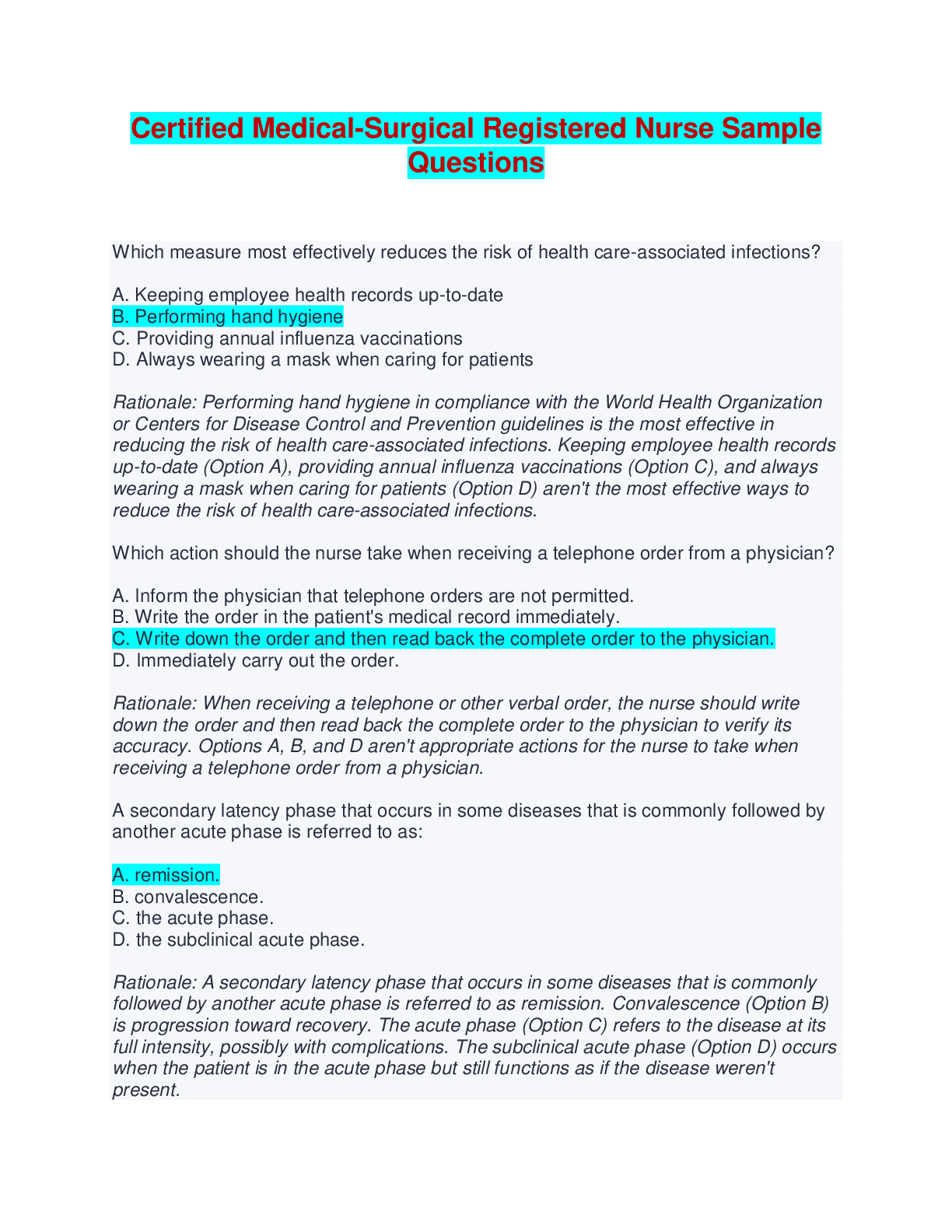
Reviews( 0 )
Document information
Connected school, study & course
About the document
Uploaded On
Apr 29, 2024
Number of pages
39
Written in
Additional information
This document has been written for:
Uploaded
Apr 29, 2024
Downloads
0
Views
7


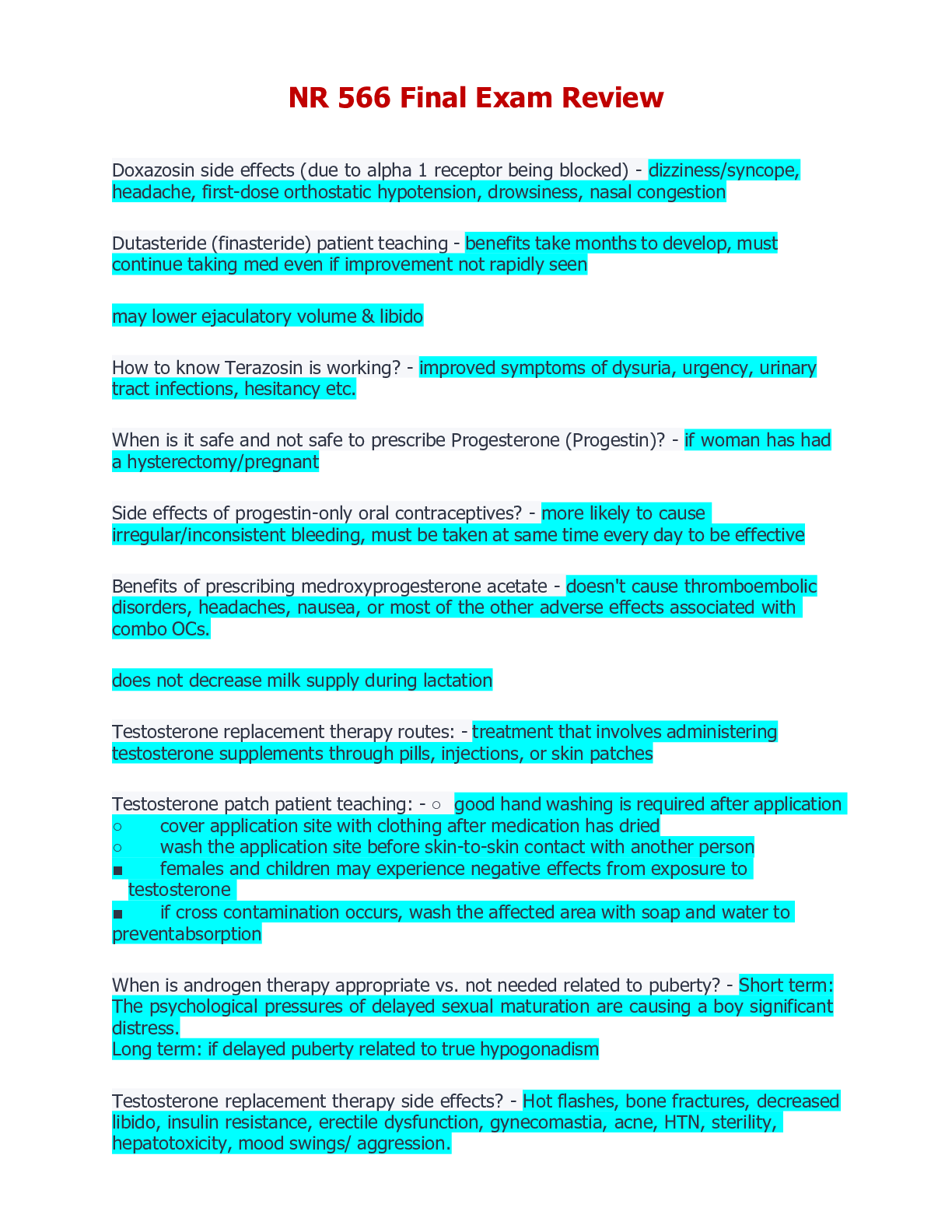
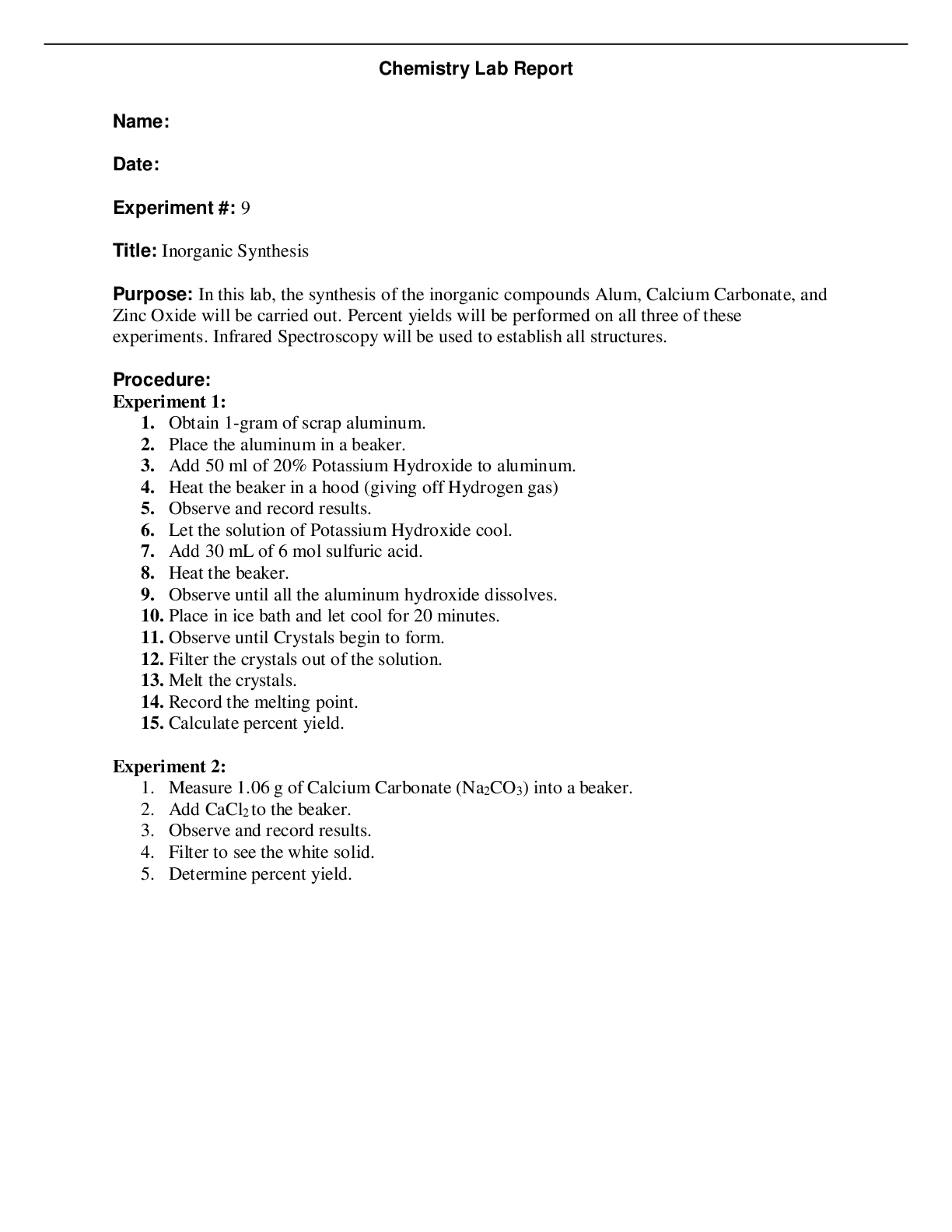
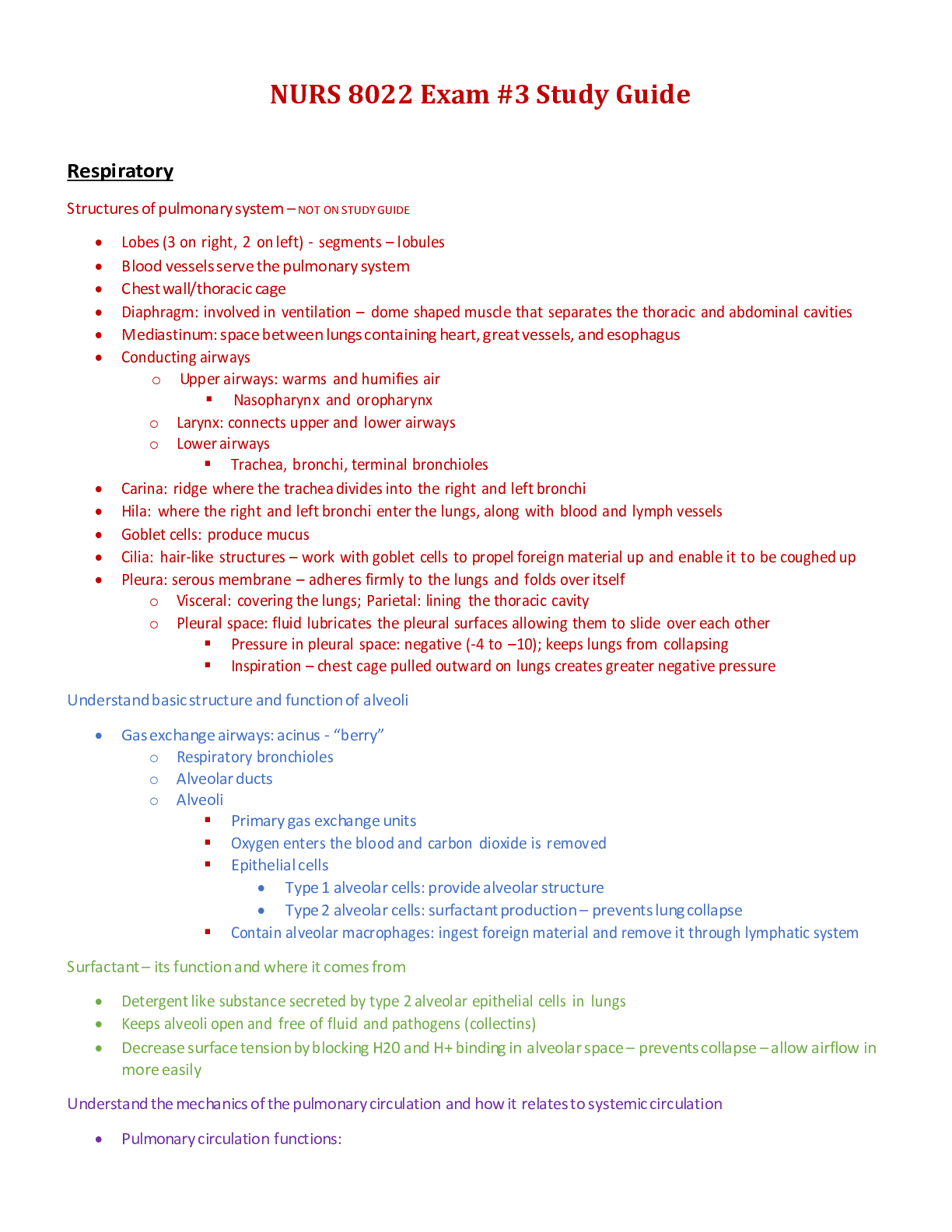
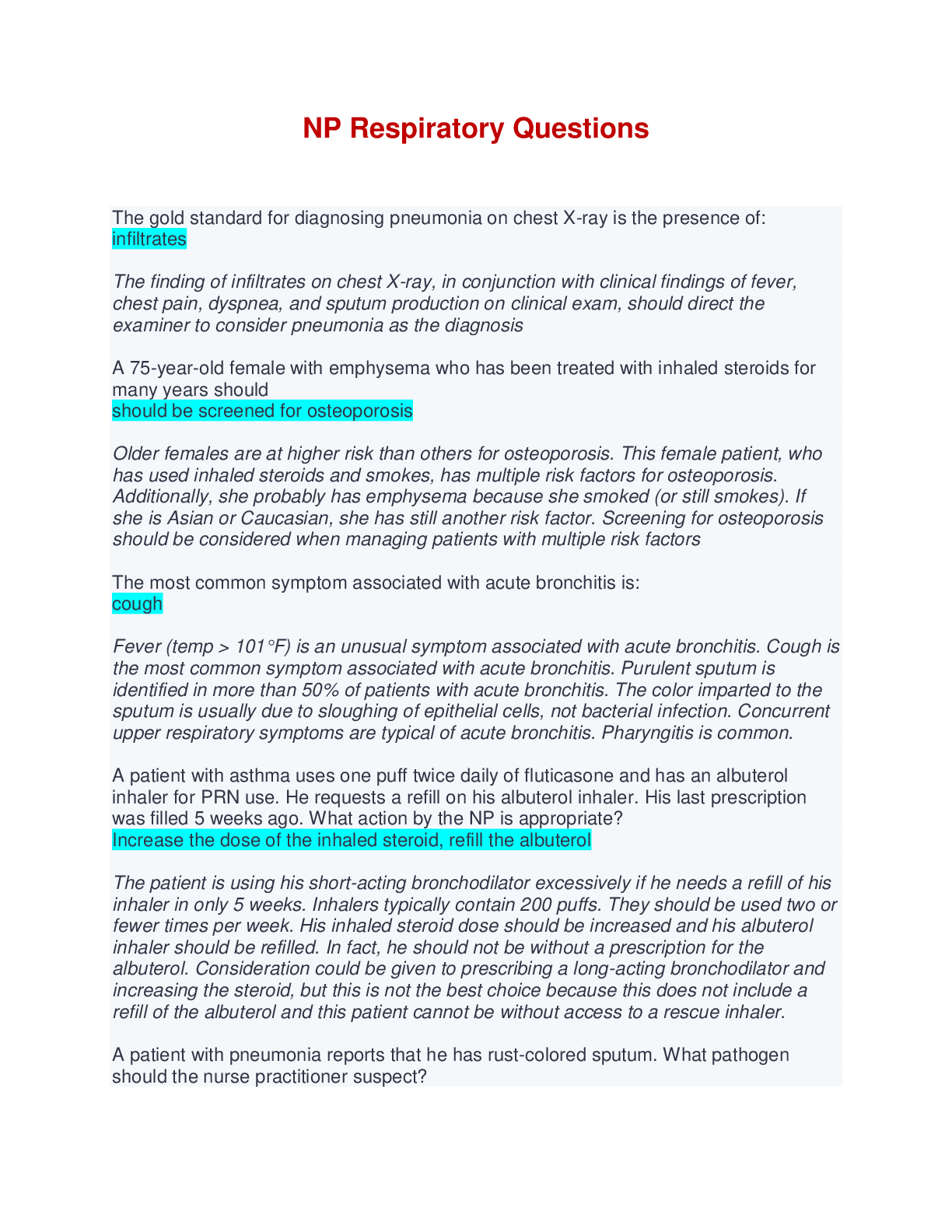

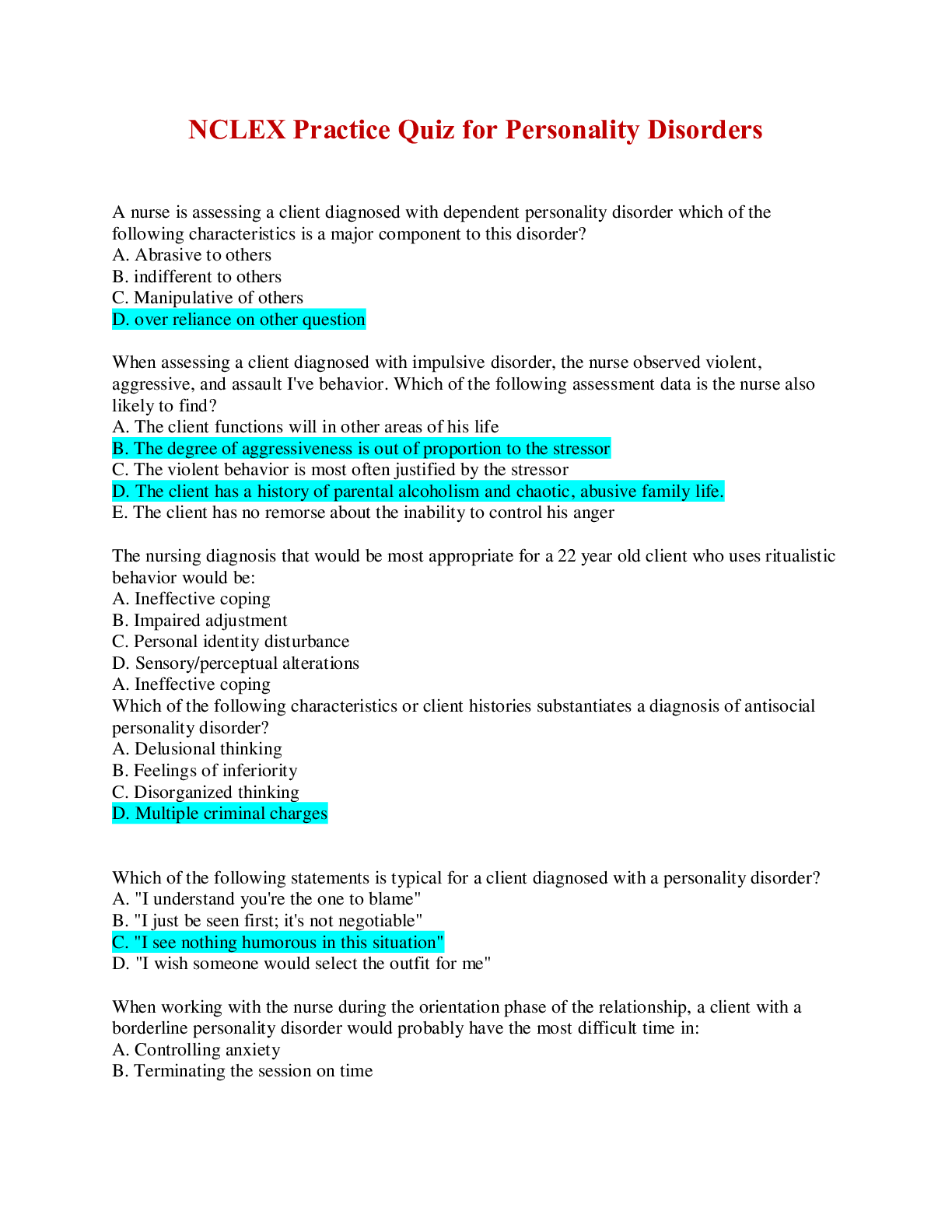



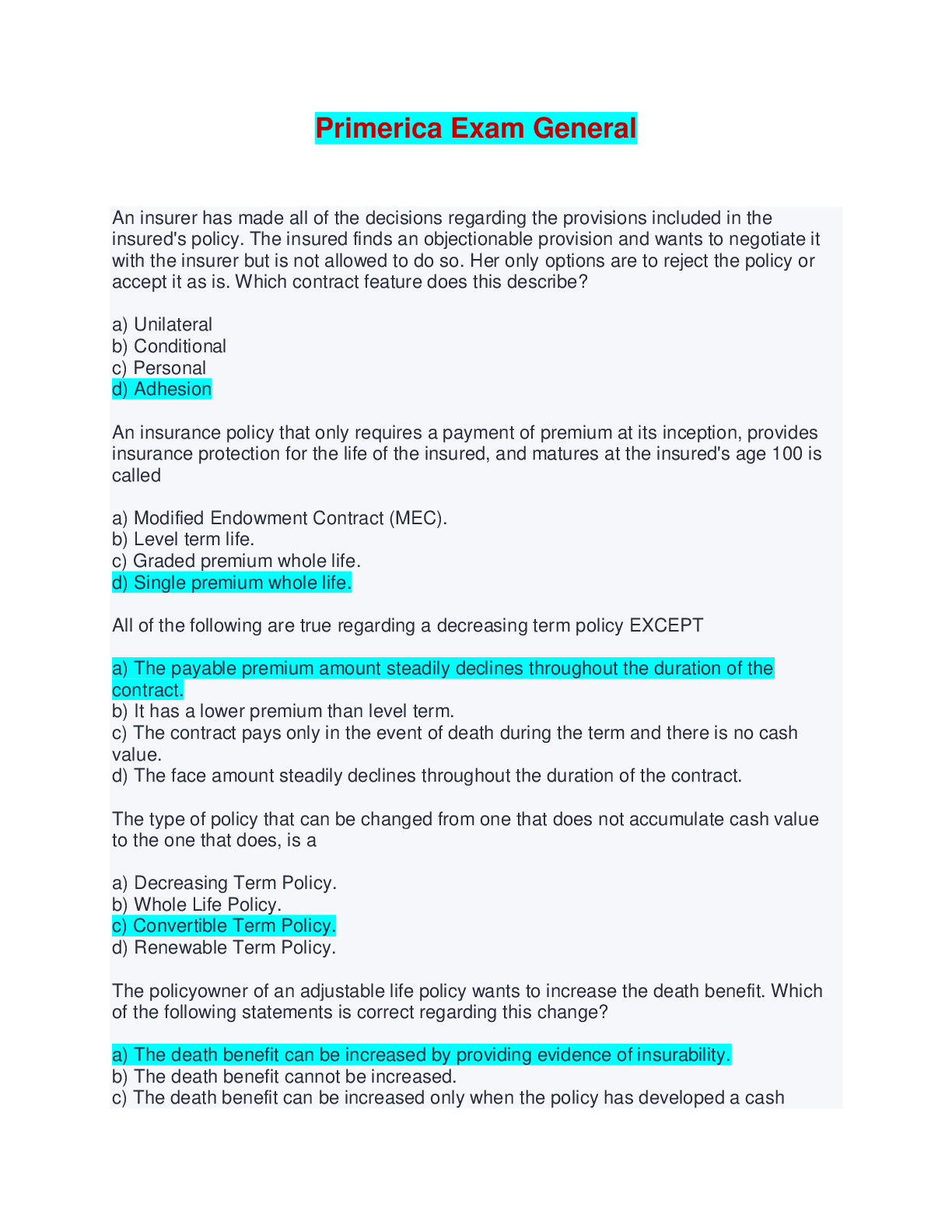

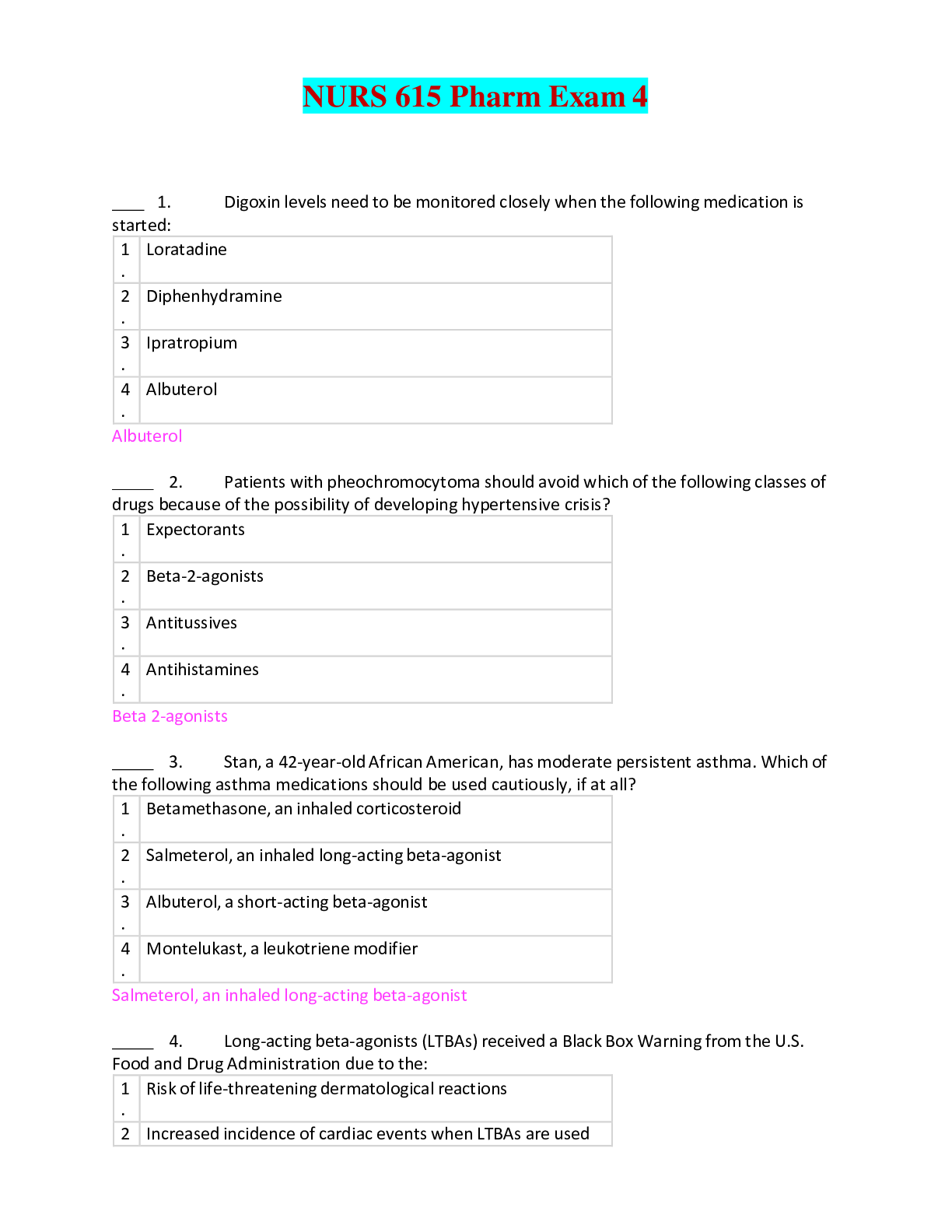
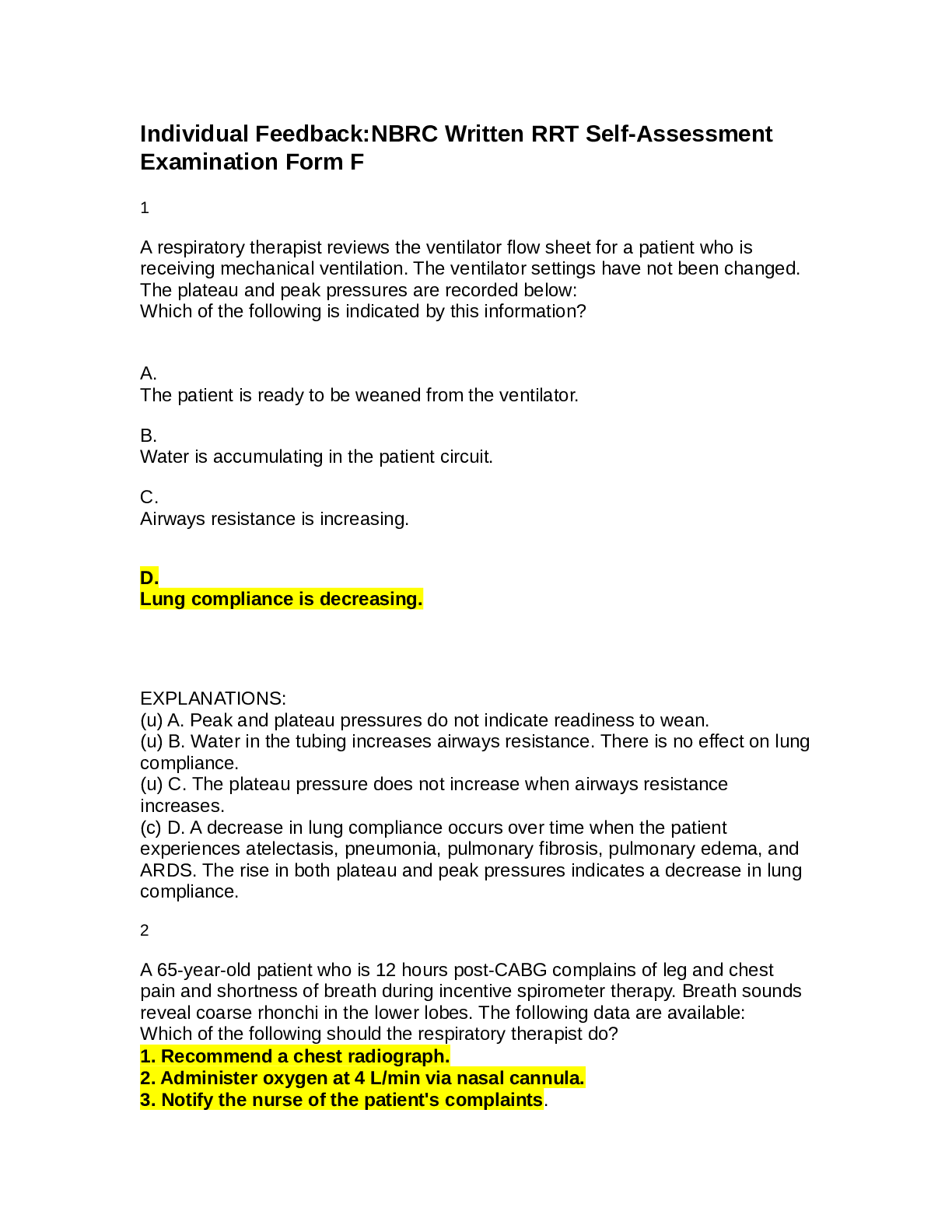
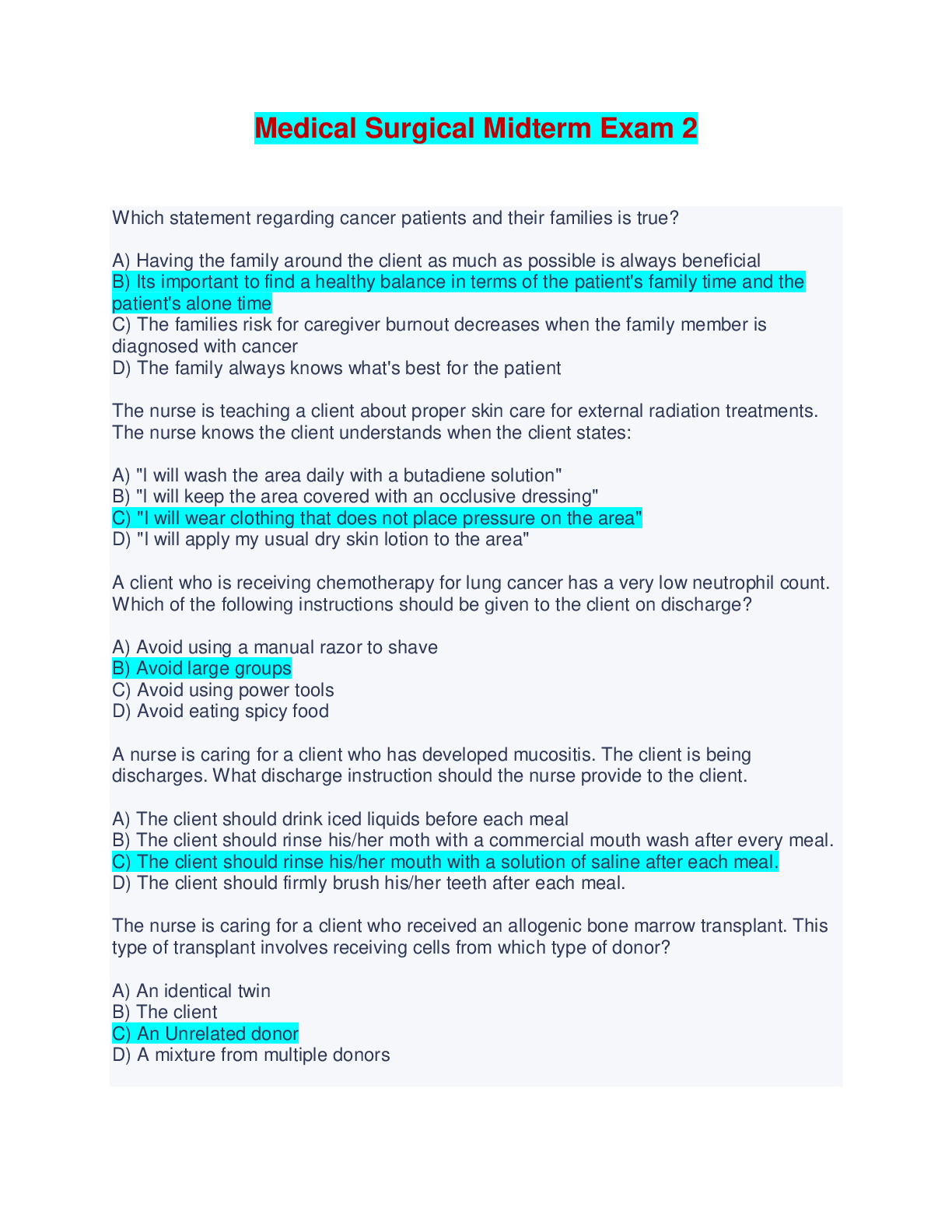
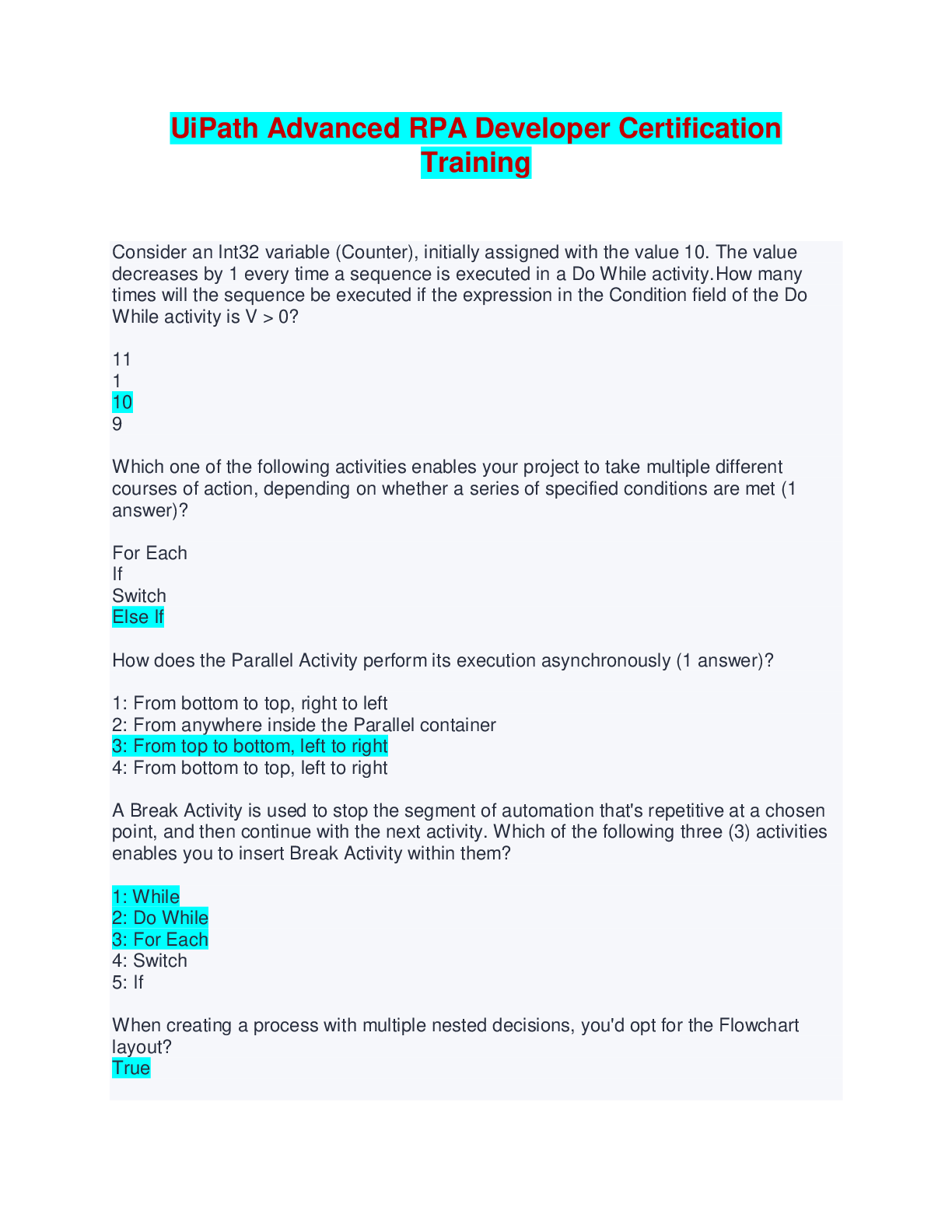
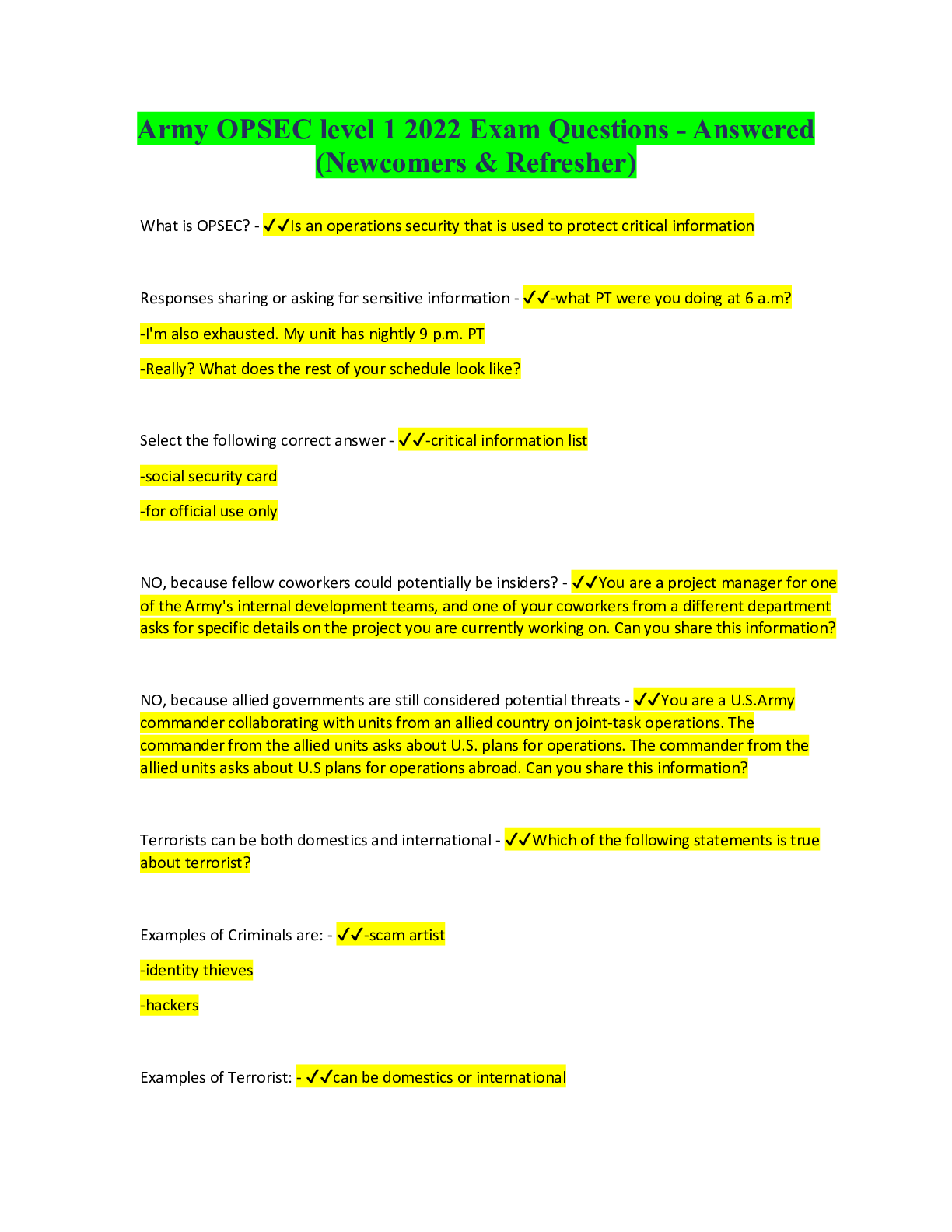
.png)
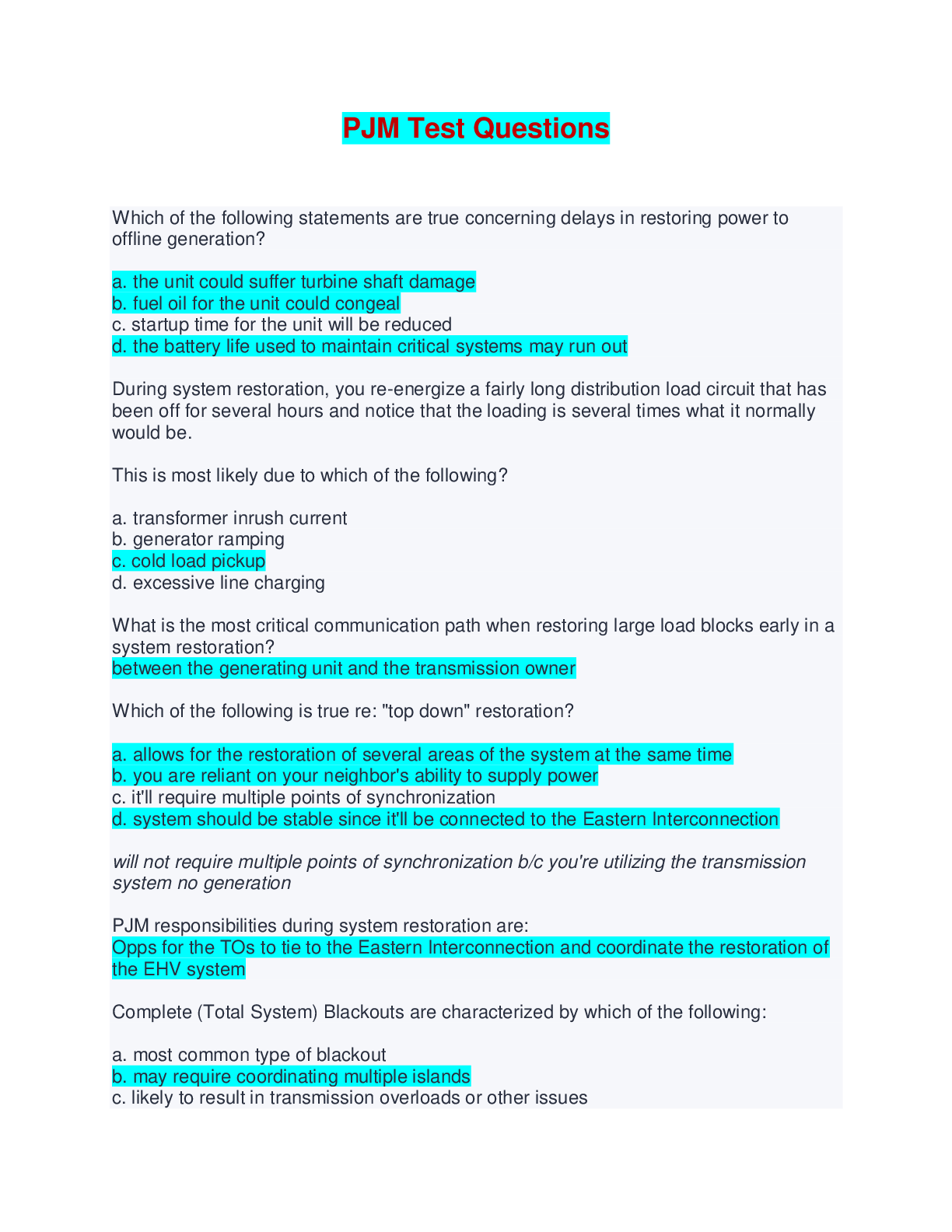
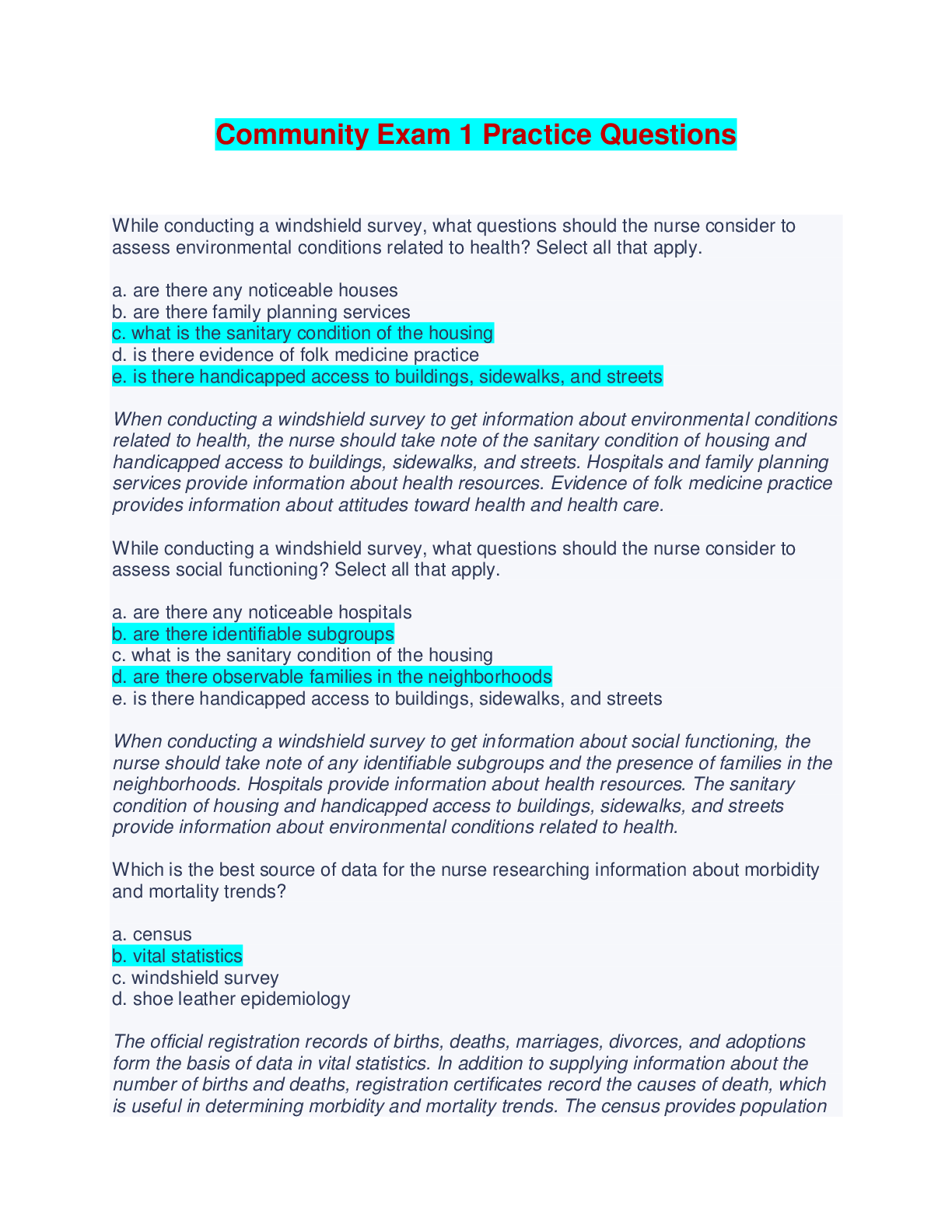

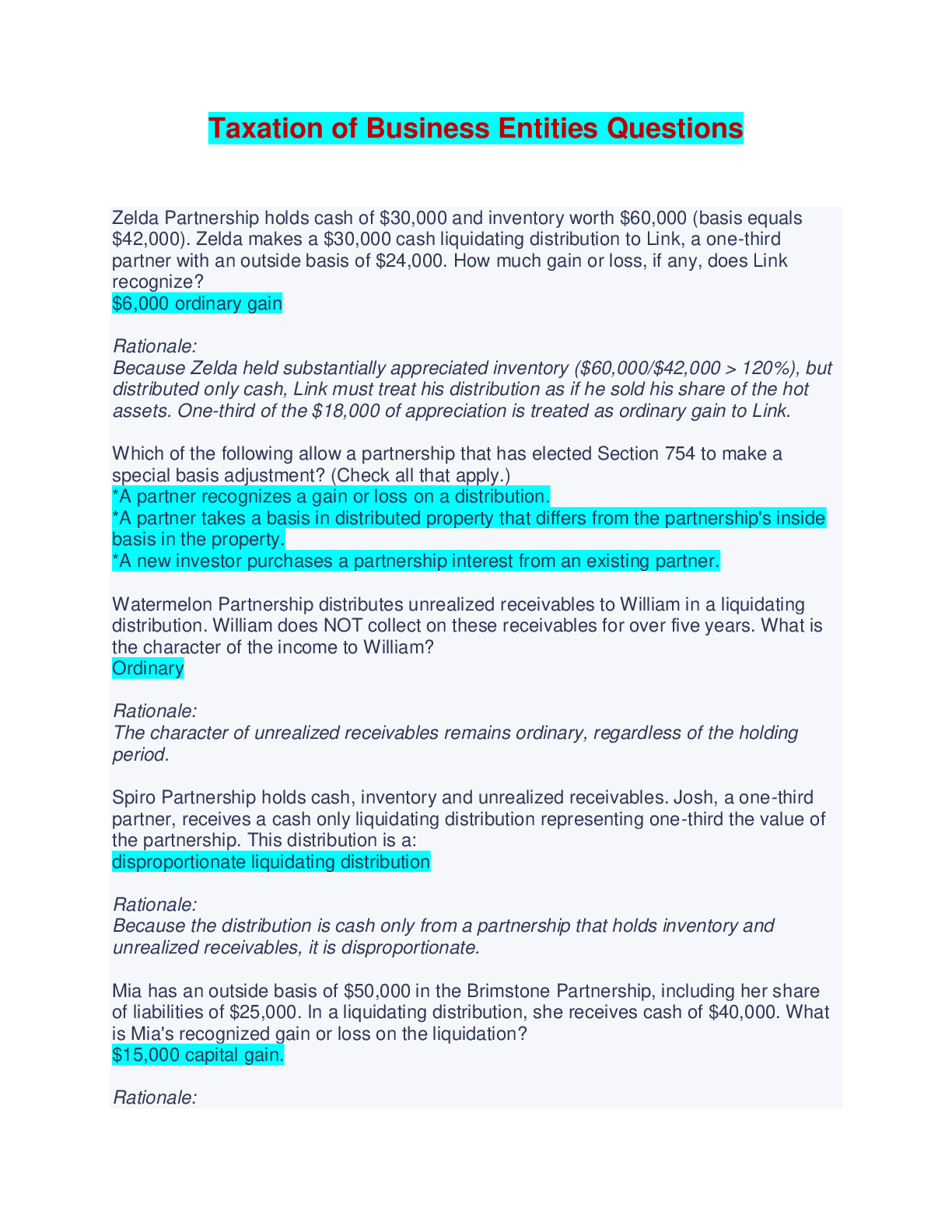

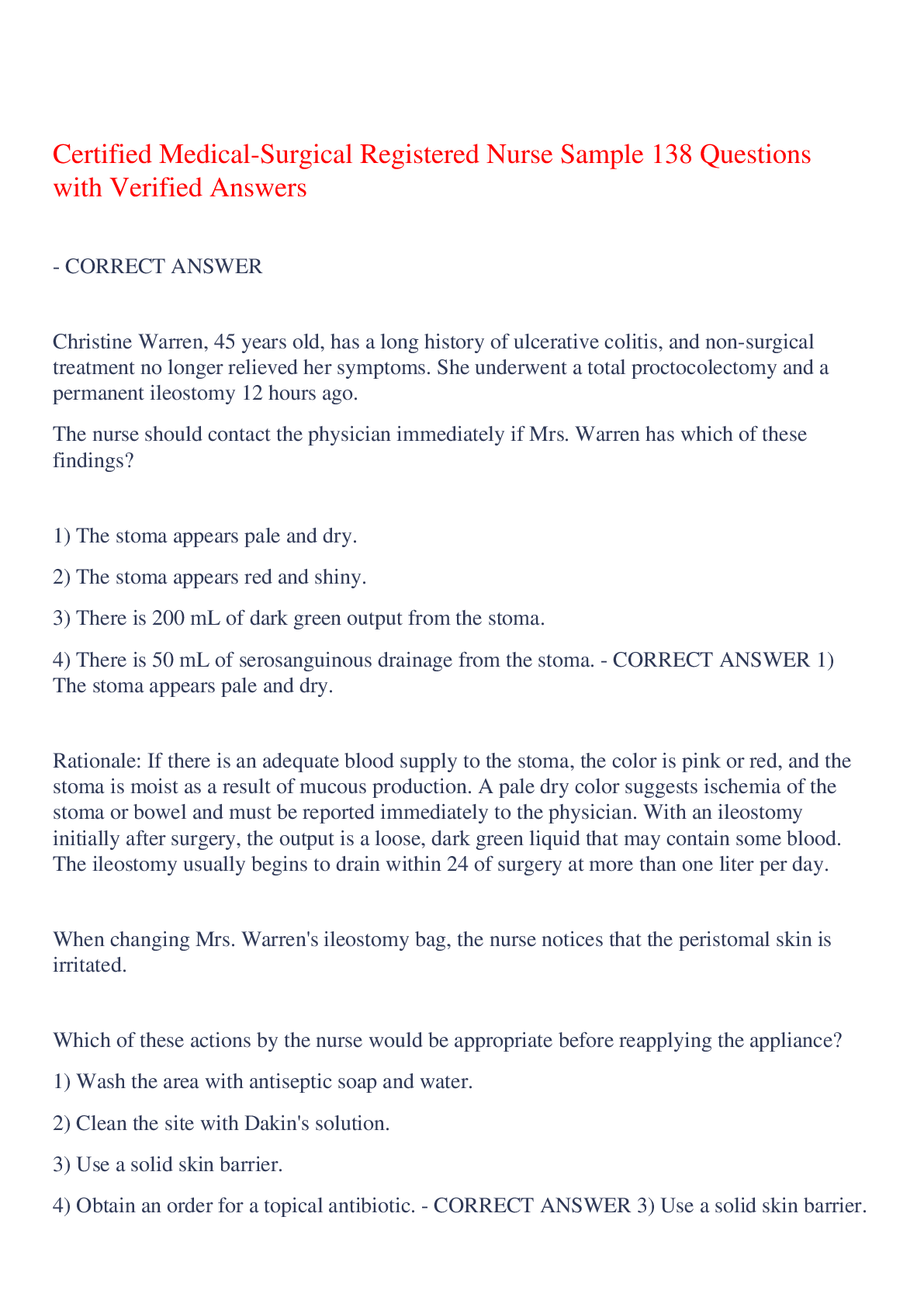
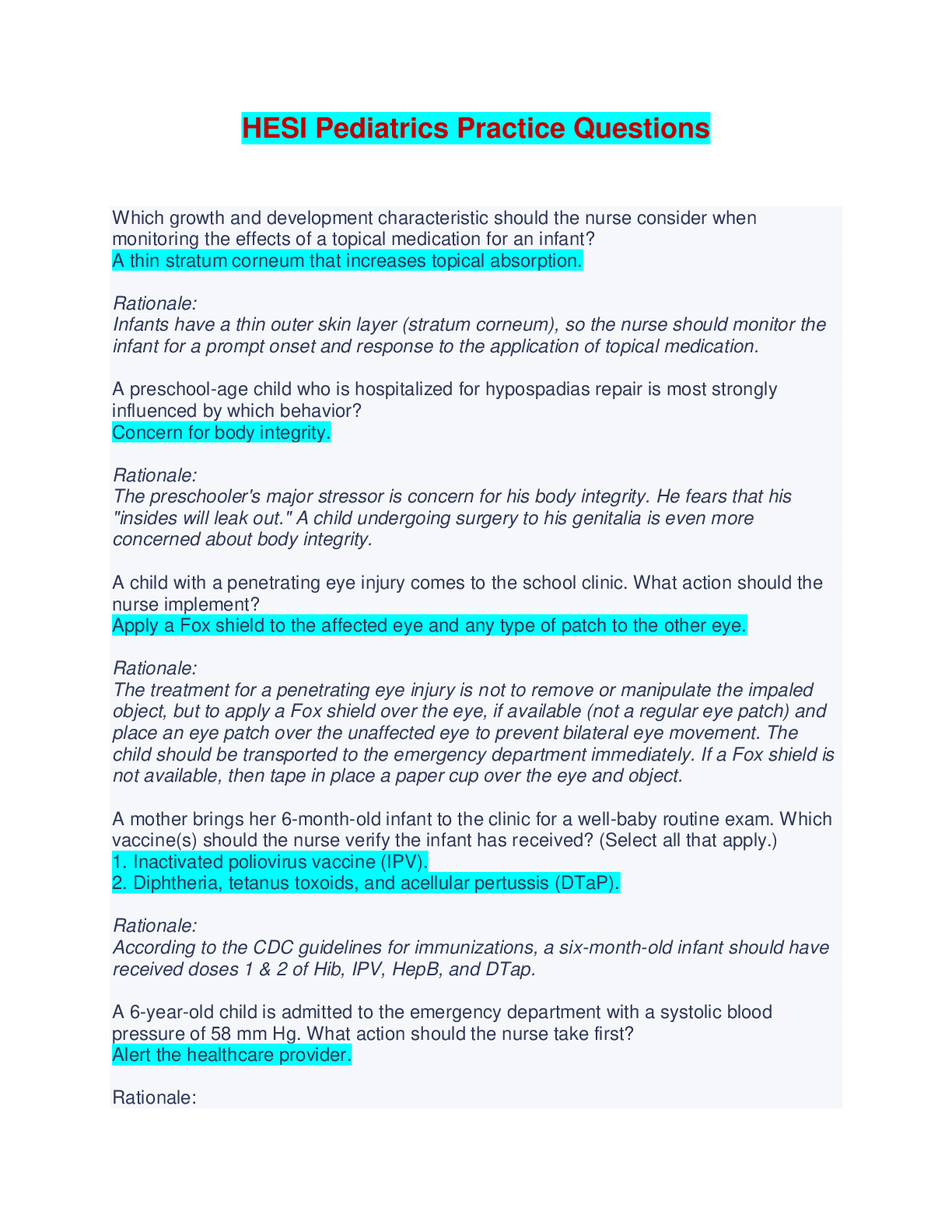
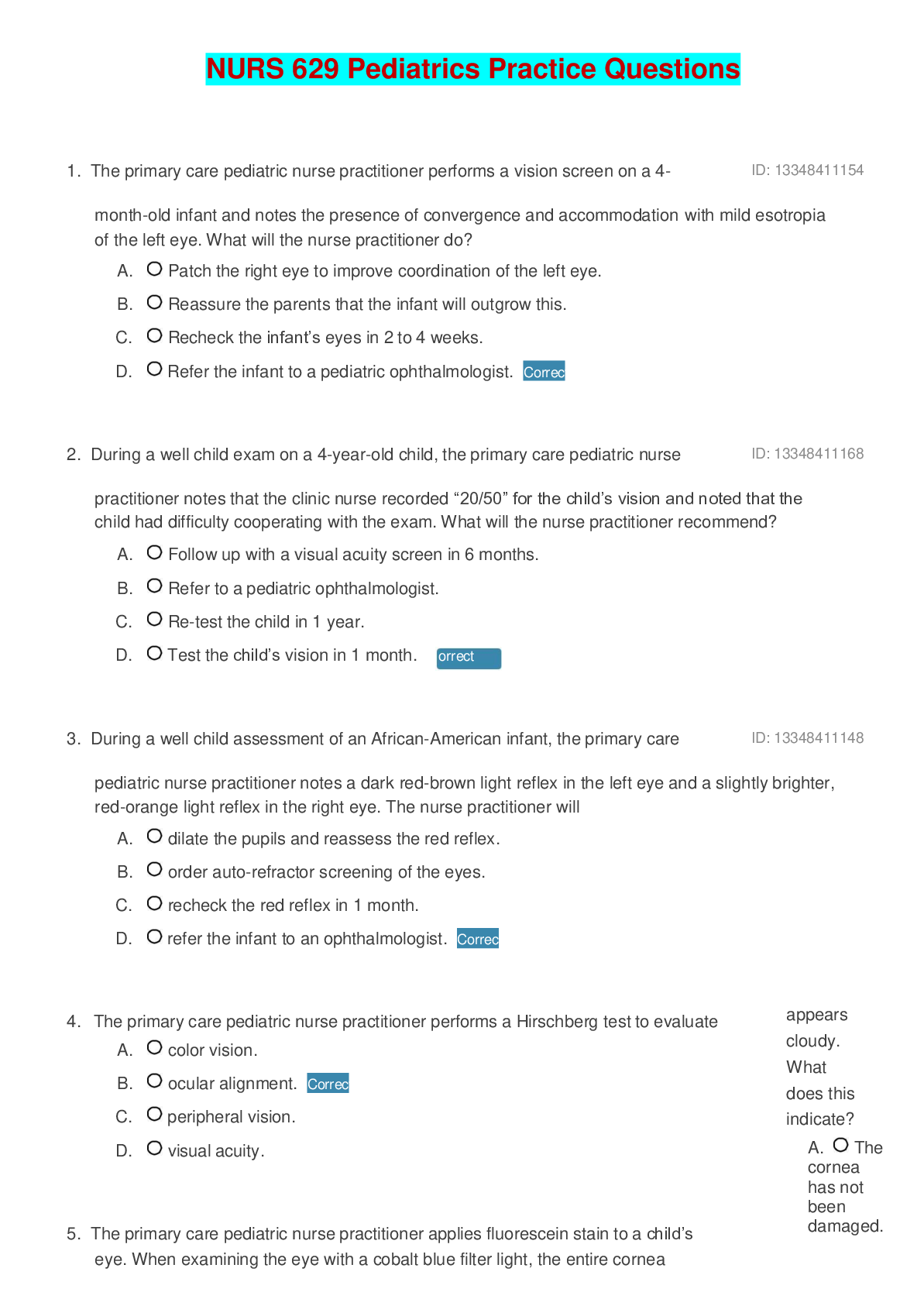
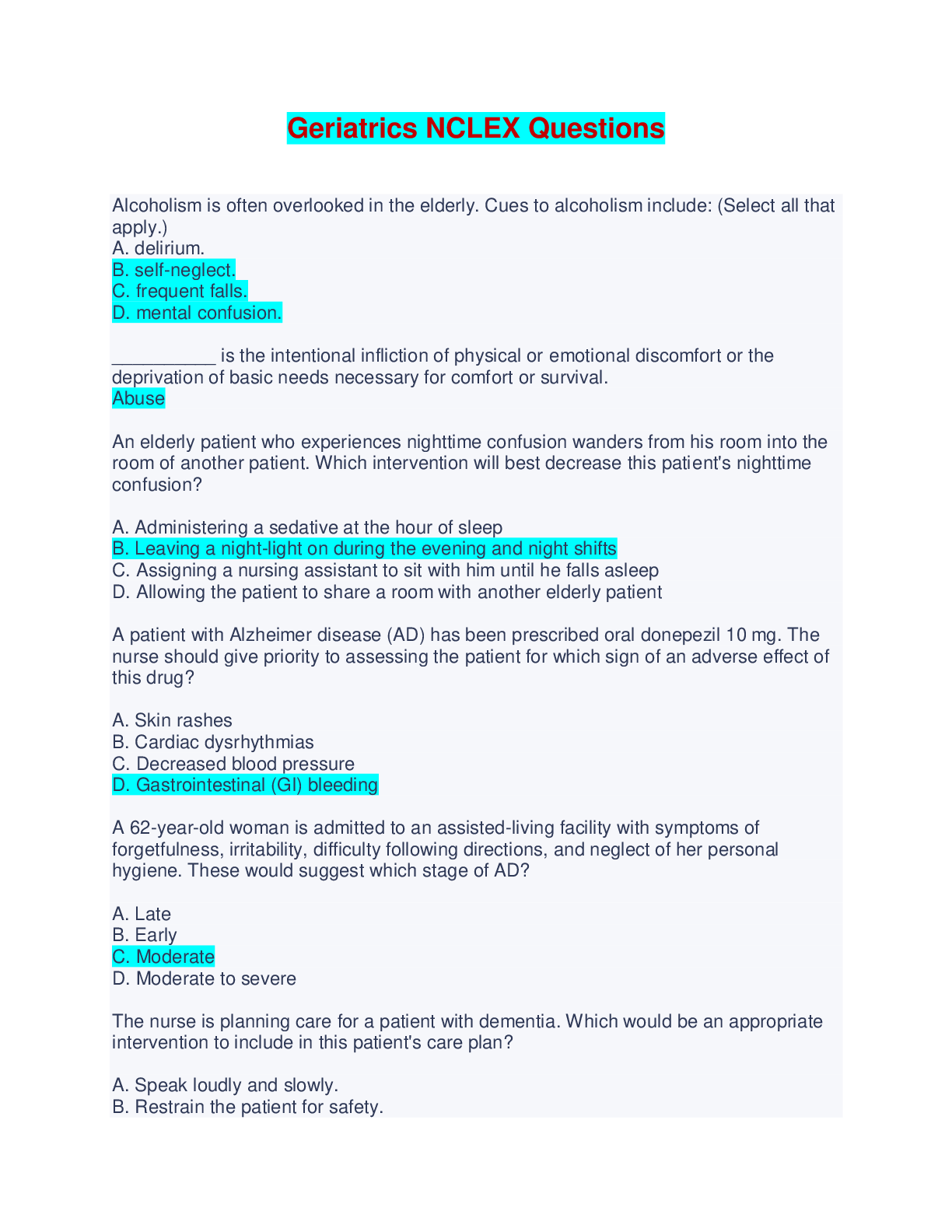
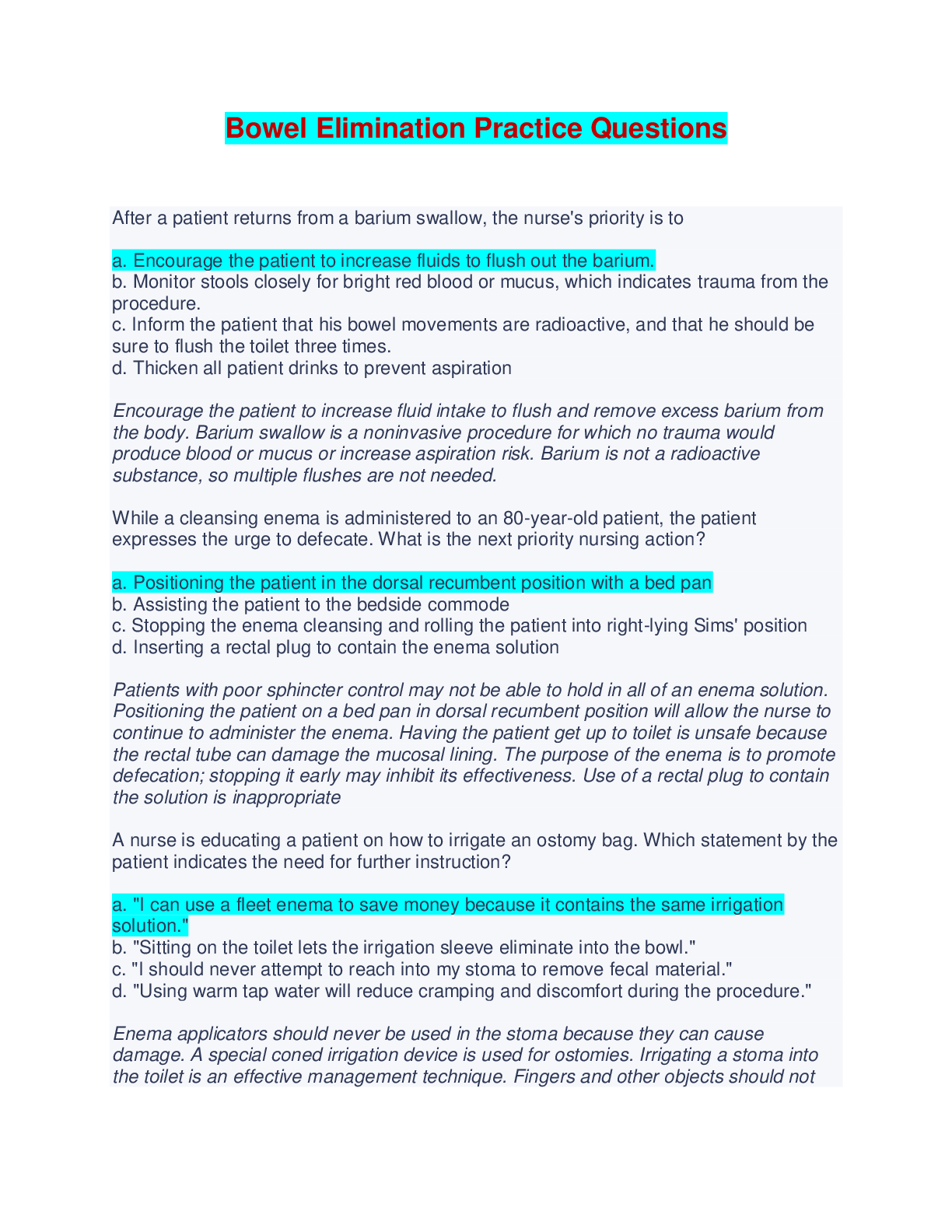

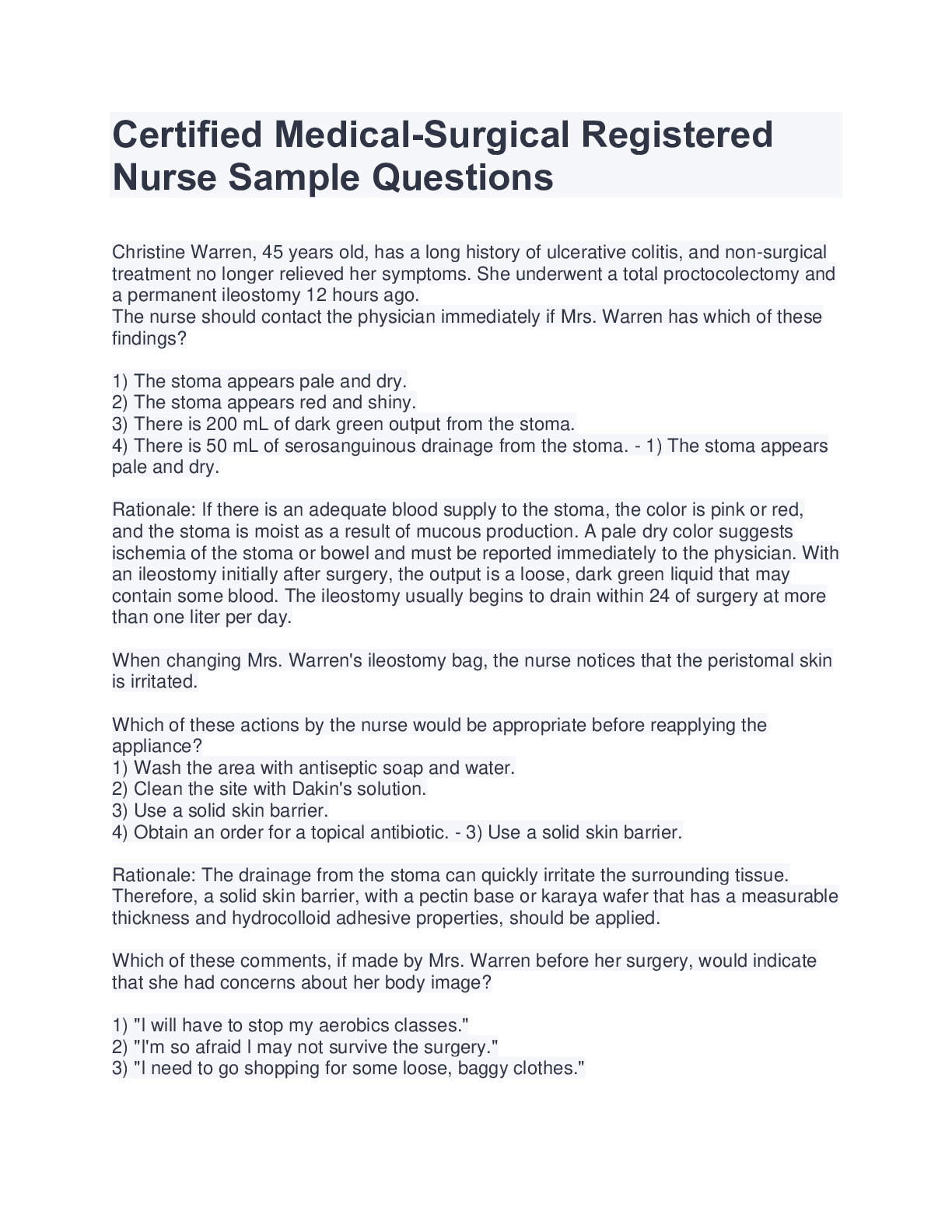
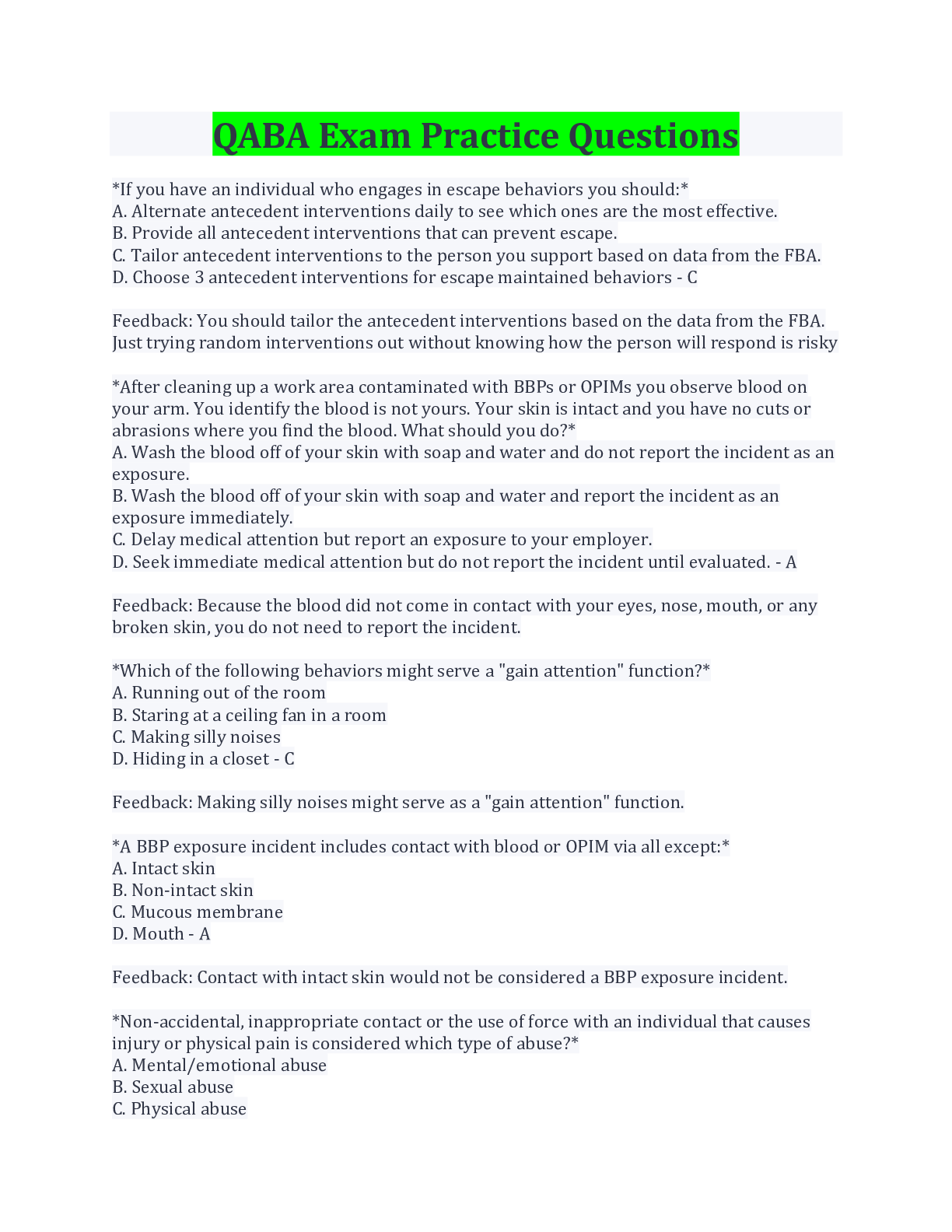

.png)



